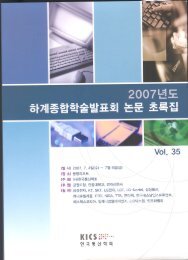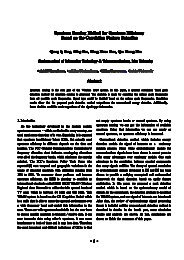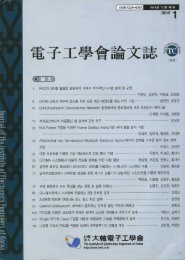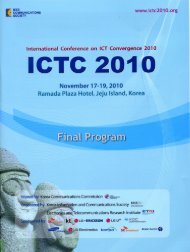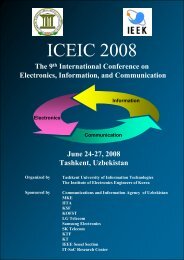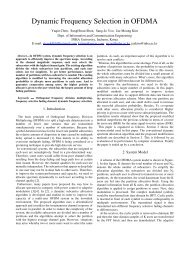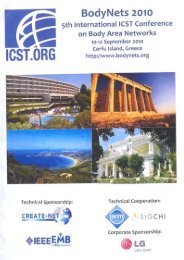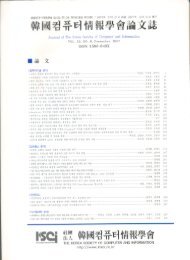An Alternative Energy Detection Using Sliding Window for Cognitive ...
An Alternative Energy Detection Using Sliding Window for Cognitive ...
An Alternative Energy Detection Using Sliding Window for Cognitive ...
You also want an ePaper? Increase the reach of your titles
YUMPU automatically turns print PDFs into web optimized ePapers that Google loves.
<strong>An</strong> <strong>Alternative</strong> <strong>Energy</strong> <strong>Detection</strong> <strong>Using</strong> <strong>Sliding</strong><br />
<strong>Window</strong> <strong>for</strong> <strong>Cognitive</strong> Radio System<br />
Young Min Kim, Guanbo Zheng, Sung Hwan Sohn and Jae Moung Kim<br />
The Graduate school of In<strong>for</strong>mation Technology & Telecommunications, Inha University<br />
Incheon, South Korea 402-751<br />
ymym@hanmail.net, gbzheng@gmail.com, kittisn@naver.com, jaekim@inha.ac.kr<br />
Abstract ⎯ <strong>Cognitive</strong> radio is one of the most effective<br />
techniques to improve the spectrum utilization efficiency. To<br />
implement the cognitive radio, spectrum sensing is considered as<br />
the key functionality because secondary users should identify the<br />
spectrum holes and utilize them efficiently without causing<br />
interference to primary users. In generally, there are three major<br />
spectrum sensing methods, including matched filter, energy<br />
detection and feature detection. The most common and simplest<br />
method is energy detection. However, the conventional energy<br />
detection suffers from large degradation in per<strong>for</strong>mance under<br />
low SNR environment. In this paper, we proposed alternative<br />
energy detection which can estimate the exact power of primary<br />
user without the noise effect and lead to the better per<strong>for</strong>mance.<br />
In order to reduce the effect of noise fluctuation, the sliding<br />
window function is utilized to assist the proposed detector. The<br />
simulation result shows that our proposed method outper<strong>for</strong>m<br />
conventional one.<br />
1. Introduction<br />
Recently, our frequency utilization is increasingly expanded<br />
due to the developing in<strong>for</strong>mation technologies in all regions<br />
of our life. More wireless communication systems are being<br />
developed and deployed which require larger coverage, higher<br />
data rate transmission and better quality to satisfy the large<br />
increasing of customers in communication service.<br />
Un<strong>for</strong>tunately, the spectrum resource is limited and almost all<br />
frequency bands are fixedly allocated according to current<br />
spectrum allocation policy, especially <strong>for</strong> the spectrum bands<br />
below 3GHz frequency. The way <strong>for</strong> fully utilizing the limited<br />
spectrum resource is becoming an open issue in wireless<br />
communication. On the other hand, from Spectrum Policy<br />
Task Force report of FCC (Federal Communications<br />
Commission) on 2002, there are a lot of temporal and<br />
geographic spectrum vacancies in the allocated spectrum,<br />
which clearly indicates the inefficiency of the fixed license<br />
spectrum policy, rather than the physical deficiency of<br />
spectrum resource [1].<br />
<strong>Cognitive</strong> Radio, the advanced software-defined radios<br />
coined by Joseph Mitola, has been considered as the best<br />
candidate technology to implement the opportunistic spectrum<br />
sharing [2]. It is an intelligent wireless communication system<br />
that can sense the spectral environment over a wide frequency<br />
band and exploit this in<strong>for</strong>mation to opportunistically provide<br />
wireless service accesses that best meet the requirements of<br />
customers. Thus, we can find out the spectrum holes and<br />
utilize them to improve the spectrum efficiency through the<br />
cognitive radio techniques.<br />
As the secondary user, the fundamental requirement of<br />
cognitive radio is to avoid interference to potential primary<br />
users in the neighborhood. Spectrum sensing has been pointed<br />
out as the key functionality in implementing cognitive radio.<br />
In order to protect primary users without reservation, cognitive<br />
radio should per<strong>for</strong>m the spectrum sensing function, detect the<br />
primary signals in occupying the spectrum bands and properly<br />
respond to changes in its environment periodically. Recent<br />
studies have proposed several methods, such as matched filter<br />
[3, 4], energy based detector [5, 6] and cyclostationarity based<br />
detector [7, 8].<br />
As we know, conventional energy detector is the most<br />
common method in signal detection. However, It has some<br />
significant disadvantages. Thus, we proposed the alternative<br />
energy detector in this paper to estimate the exact primary user<br />
power without noise effect, which can lead to the better<br />
detection per<strong>for</strong>mance. <strong>An</strong>d the sliding window scheme is<br />
utilized to assist the detector <strong>for</strong> better per<strong>for</strong>mance. The<br />
particulars are explained by next part.<br />
The reminder of this paper is organized as follows: in<br />
section II, conventional energy detection is briefly reviewed.<br />
Then our proposed algorithm is explored in section III. In<br />
order to verify the proposed algorithm, the simulation result is<br />
shown and discussed in section IV. Finally, we make a<br />
conclusion about the paper in section V.<br />
2. Conventional <strong>Energy</strong> <strong>Detection</strong>.<br />
<strong>Energy</strong> detection is the most common method <strong>for</strong> spectrum<br />
sensing because of its non-coherency and low complexity.<br />
Conventional energy detector can be simply implemented like<br />
spectrum analyzer, the block diagram of which is drawn in<br />
figure 1.<br />
Figure 1. Conventional <strong>Energy</strong> <strong>Detection</strong><br />
After analog to digital conversion of the received signal, we<br />
can get the N frequency samples by N-point FFT. Then the<br />
signal power is estimated through the simple calculation of<br />
each sample in frequency domain. Finally, primary user signal
is declared to exist when the signal power is larger than the<br />
threshold. The detection is generally described under the test<br />
of the following two hypotheses:<br />
1) H0 : x(n) = w(n), signal is absent<br />
2) H1 : x(n) = s(n)+w(n), signal is present<br />
where w(n) is additive white Gaussian noise with zero mean,<br />
s(n) represents the received primary user signal.<br />
However, there are some significant drawbacks. The main<br />
problem is the defective effect due to the decrease of<br />
difference between signal and noise level. Since it uses<br />
predefined threshold <strong>for</strong> signal detection, which makes the<br />
per<strong>for</strong>mance highly rely on the noise level. For the case of low<br />
SNR environment or fading channel, the per<strong>for</strong>mance<br />
degrades largely and makes the detector useless. <strong>An</strong>other<br />
disadvantage is energy detector can not identify the type of<br />
primary signal occupying the frequency band. It can not<br />
distinguish one primary user from others. Thus, we proposed<br />
the algorithm which can relieve the drawbacks and make the<br />
better per<strong>for</strong>mance.<br />
3. <strong>Alternative</strong> <strong>Energy</strong> <strong>Detection</strong> Algorithm<br />
The proposed alternative energy detection algorithm, based<br />
on optimal radiometer concept, is employed in this paper. In<br />
order to detect the possible primary user signal, we first<br />
observe the frequency spectrum of received signal, as shown<br />
in figure 2. We suppose primary user has a perfect guard band,<br />
where BWob is the observed bandwidth, BWeff is the effective<br />
bandwidth only occupied by primary user, BWGB1 and BWGB2<br />
are the guard band both sides of primary user.<br />
Considering the signal spectrum mentioned above, we can<br />
easily detect the signal of PU2 using the proposed detector.<br />
The primary signal with noise exists together in BWeff, while<br />
there is only noise power in BWGB1 and BWGB2. There<strong>for</strong>e, if<br />
we can find the location of BWGB1 and BWGB2, it is possible to<br />
calculate the exact primary signal power without the noise part<br />
and then decide the existence of the primary signal. The<br />
proposed detection scheme is described in next steps.<br />
Figure 2. The Observed Spectrum of the Received Signal<br />
First, we can estimate the noise power in guard band BWGB1<br />
which indicates the only noise part. Here the noise is<br />
considered to be AWGN, which has the zero mean and<br />
variance σ 2 . <strong>Using</strong> this value, we can get accurate noise power<br />
in primary user occupancy band BWeff, as demonstrated in (1).<br />
P ×<br />
BW<br />
eff<br />
n,<br />
eff = Pn<br />
, GB<br />
(1)<br />
1 BWGB1<br />
where Pn,eff is noise power in effective bandwidth, Pn,GB1 is<br />
noise power in guard band 1. The guard band 2 can be<br />
described the same as the guard band 1. There<strong>for</strong>e, the exact<br />
primary signal power in BWeff can be described by:<br />
P s,<br />
eff Ps<br />
n,<br />
eff − Pn<br />
, eff<br />
= + (2)<br />
where Ps,eff is the only primary signal power except the noise<br />
power in effective band (BWeff), Ps+n,eff is the primary signal<br />
power adding the noise power in effective band (BWeff).<br />
There<strong>for</strong>e, we got the estimated value of only primary user’s<br />
power Ps,eff. This is the ideal case <strong>for</strong> alternative energy<br />
detector. However, the real signal spectrum does not have the<br />
perfect guard band. Due to the interference, noise fluctuation<br />
and out of band radiation, etc, it is difficult to identify the<br />
guard band from the band occupied by primary signal. Thus,<br />
we need to work on guard band identification. In this paper,<br />
with the help of sliding window to decrease the noise effect,<br />
we try to find the guard band by using the first threshold. If the<br />
power sample is lower than threshold, the region is decided to<br />
be in the guard band.<br />
From the description above, an alternative energy detection<br />
algorithm is proposed. The block diagram is shown in figure 3,<br />
while the details are explained in the following parts.<br />
A. Original Spectrum Shaping<br />
This step is same to conventional energy detection based on<br />
FFT. First, the received signal xa(t) is sampled with Nyquist<br />
sampling rate in <strong>An</strong>alog to Digital Converter and changed to<br />
the digital signal [9, 10].<br />
Then, the received signal is changed to frequency domain<br />
signal by N-point FFT, while the frequency sample X(k) by<br />
can be described in the following by DFT equation:<br />
X ( k)<br />
1<br />
= ∑ − N<br />
n=<br />
0<br />
x(<br />
n)<br />
e<br />
j2πnk / N<br />
0 ≤ k ≤ N −1<br />
The power sample P(k) is calculated by squaring each<br />
frequency samples X(k).<br />
B. <strong>Sliding</strong> <strong>Window</strong><br />
In order to reduce the defective effect due to noise level<br />
fluctuation in real signal, the sliding window is employed to<br />
assist the proposed detector. A sliding window algorithm<br />
places a buffer between power samples <strong>for</strong> adding all sample<br />
(3)
values of window size and averaging these. The sliding<br />
window size is pre-defined and saved in the memory. After<br />
averaging in total window, it is shifted to next sample up to<br />
last sample. The power samples are passed through the sliding<br />
window to get the smoother curve. The k-th window w(k) is<br />
defined as:<br />
N 1<br />
wk ( ) = ∑ Pkn ( , )<br />
(4)<br />
N =<br />
n 1<br />
where N indicates the window size.<br />
We can confirm this fact through the next example. When we<br />
consider DTV signal as primary user, which is VSBmodulated.<br />
The spectrum of DTV signal with SNR 10dB and -<br />
5dB are shown in figure 4 and figure 5, respectively.<br />
Obviously, the detection would be very difficult in low SNR<br />
environment due to the significant fluctuation. After passing<br />
the sliding window, the spectrum of DTV signal with SNR -<br />
5dB is drawn in figure 6. Comparing this with figure 5, we can<br />
see the per<strong>for</strong>mance is improved a lot after using sliding<br />
window.<br />
Magnitude<br />
-35<br />
-40<br />
-45<br />
-50<br />
-55<br />
-60<br />
-65<br />
-70<br />
0 1 2 3 4 5 6 7 8 9 10<br />
Frequency (MHz)<br />
Figure 3. The Block Diagram of <strong>Alternative</strong> <strong>Energy</strong> Detector <strong>Using</strong> <strong>Sliding</strong> <strong>Window</strong><br />
Figure 4. The Spectrum of DTV Signal with SNR 10dB<br />
Magnitude<br />
Magnitude<br />
-40<br />
-45<br />
-50<br />
-55<br />
-60<br />
-65<br />
-70<br />
0 1 2 3 4 5 6 7 8 9 10<br />
Frequency (MHz)<br />
-98<br />
-99<br />
-100<br />
-101<br />
-102<br />
-103<br />
Figure 5. The Spectrum of DTV Signal with SNR -5dB<br />
p g ( g )<br />
-104<br />
0 1 2 3 4 5 6 7 8 9 10<br />
Frequency (MHz)<br />
Figure 6. The Spectrum of DTV Signal with SNR -5dB<br />
after <strong>Sliding</strong> <strong>Window</strong><br />
C. Guard Band Identification<br />
This step in proposed algorithm is to identify the guard band,<br />
which includes the noise part only. With the help of sliding<br />
window, it is easier <strong>for</strong> us to divide guard band from occupied<br />
band by the preset threshold:<br />
1) Pw < Thr1 : region of guard band<br />
2) Pw > Thr1 : region of primary user occupying band
where Pw is the power of frequency sample after sliding<br />
window, Thr1 is the preset threshold 1. If the power is larger<br />
than threshold 1, the sample is considered in the range of<br />
primary user occupying band. Otherwise, we consider it the<br />
sample in guard band. Based on this method, the guard band is<br />
estimated and differentiated from primary signal occupying<br />
band.<br />
D. Primary Signal Decision<br />
This is the last step to decide the existence of primary user<br />
signal. Since the guard band is identified from the primary<br />
signal occupying band, we can calculate the only noise power<br />
in the guard band and find the power of noise part in primary<br />
signal occupying band through (1). Then, we can estimate the<br />
only power of primary signal by using (2). Finally, using the<br />
preset threshold 2, the existence of primary signal is declared<br />
to exist.<br />
1) E > Thr2: primary user signal exist.<br />
2) E < Thr2: primary user signal is absent.<br />
where E is the estimated value of signal power only. If the<br />
estimated signal power is larger than Threshold 2, the<br />
existence of primary user is declared. Otherwise, the absence<br />
of primary user is declared. As a result, we can detect the<br />
existence of primary user signal by alternative energy detector.<br />
4. Simulation Results<br />
In order to evaluate the per<strong>for</strong>mance of proposed algorithm,<br />
the simulation is per<strong>for</strong>med with a pair of probabilities Pd and<br />
Pf. Pd is the detection probability, while Pf indicates the false<br />
alarm probability. Furthermore, the specific thresholds are<br />
selected to meet with the requirement of Pf smaller than 10%.<br />
The parameters including threshold 1 and 2, sliding window<br />
size, FFT size are fully considered in the paper.<br />
The per<strong>for</strong>mance of ATSC DTV signal using the proposed<br />
algorithm is evaluated with comparison to that of conventional<br />
energy detection in figure 7. Comparing to the conventional<br />
one, under the same Pd 90%, the proposed method has about<br />
7.5dB SNR gain. This is the reason that the primary signal is<br />
easily detected by using sliding window and guard band<br />
identification scheme.<br />
The effect of different window sizes is evaluated to illustrate<br />
the per<strong>for</strong>mance of the proposed detector as shown in figure 8.<br />
Larger the window size, better detection per<strong>for</strong>mance because<br />
the larger sliding window is more effected by averaging. There<br />
is almost 4dB gain with window size increasing from 10 to<br />
300. Moreover, the per<strong>for</strong>mance with different FFT sizes is<br />
evaluated in figure 9. The simulation result of lager FFT size<br />
has better per<strong>for</strong>mance than small FFT size. In general, in case<br />
of large FFT, the simulation has better per<strong>for</strong>mance. Under the<br />
same Pd 90%, the per<strong>for</strong>mance shows almost 3dB gain with<br />
FFT size increasing from 512 and 2048.<br />
Probablity of <strong>Detection</strong><br />
1<br />
0.9<br />
0.8<br />
0.7<br />
0.6<br />
0.5<br />
0.4<br />
0.3<br />
0.2<br />
Altervative<br />
energy detection<br />
0.1<br />
Conventional<br />
energy detection<br />
0<br />
-20 -18 -16 -14 -12 -10 -8 -6 -4 -2 0<br />
SNR(Eb/N0)<br />
Figure 7. Per<strong>for</strong>mance <strong>for</strong> DTV Signal <strong>Detection</strong> Comparing to<br />
Conventional one (<strong>Window</strong> Size: 300; FFT Size: 2048; AWGN)<br />
Probablity of <strong>Detection</strong><br />
1<br />
0.9<br />
0.8<br />
0.7<br />
0.6<br />
0.5<br />
0.4<br />
0.3<br />
window size=300<br />
0.2<br />
window size=200<br />
window size=100<br />
0.1<br />
window size=50<br />
window size=10<br />
0<br />
-20 -15 -10 -5<br />
SNR(Eb/N0)<br />
Figure 8. Per<strong>for</strong>mance <strong>for</strong> DTV Signal <strong>Detection</strong> with Different <strong>Window</strong><br />
Size (FFT Size: 2048; AWGN)<br />
Probablity of <strong>Detection</strong><br />
1<br />
0.9<br />
0.8<br />
0.7<br />
0.6<br />
0.5<br />
0.4<br />
0.3<br />
0.2<br />
0.1<br />
FFT size=2048<br />
FFT size=1024<br />
FFT size=512<br />
0<br />
-20 -15 -10 -5<br />
SNR(Eb/N0)<br />
Figure 9. Per<strong>for</strong>mance <strong>for</strong> DTV Signal <strong>Detection</strong> with Different FFT Size<br />
(<strong>Window</strong> Size: 300; AWGN)
5. Conclusions<br />
For spectrum sensing of cognitive radio, conventional energy<br />
detection suffers from bad per<strong>for</strong>mance under low SNR<br />
environment. Thus, we proposed the alternative energy<br />
detector which can estimate the exact PU power without noise<br />
effect. Furthermore, in order to appease the noise fluctuation,<br />
the sliding window scheme is utilized to assist the detector.<br />
The simulation result proves the better detection per<strong>for</strong>mance<br />
over conventional one. In our future work, we will focus on<br />
evaluating our proposed method under the environment with<br />
adjacent channel interference and will introduce the more<br />
realistic environment.<br />
ACKNOWLEDGMENT<br />
This work was supported by the Korea Science and<br />
Engineering Foundation (KOSEF) through the National<br />
Research Lab. Program funded by the Ministry of Science and<br />
Technology (No. M10600000194-06J0000-19410) and<br />
supported by the MIC (Ministry of In<strong>for</strong>mation and<br />
Communication), Korea, under the ITRC (In<strong>for</strong>mation<br />
Technology Research Center) support program supervised by<br />
the IITA(Institute of In<strong>for</strong>mation Technology Assessment)"<br />
(IITA-2006-C1090-0603-0019)<br />
REFERENCES<br />
[1] Federal Communication Commission, “Spectrum Policy Task Force<br />
Report”, ET Docket No. 02-155, Nov. 2002.<br />
[2] J. Mitola, “<strong>Cognitive</strong> Radio: <strong>An</strong> Integrated Agent Architecture <strong>for</strong><br />
Software Defined Radio”, Ph. D thesis, Royal Institute of Technology<br />
and Sweden.<br />
[3] D. Cabric, S. Mishra, and R. Brodersen, “Implementation issues in<br />
spectrum sensing <strong>for</strong> cognitive radios”, in Proc. Asilomar Conf. On<br />
signals, Systems and Computers, vol. 1, Nov. 2004, pp. 772-776<br />
[4] D.Cabric, A.Tkachenko, and R. Brodersen, “Spectrum sensing<br />
measurements of pilot, energy, and collaborative detection”, in Proc.<br />
IEEE Military Communications Conf., Oct. 2006, pp. 1-7.<br />
[5] Guanbo Zheng, Ning Han, Xiaoge Huang, Sung Hwan Sohn, Jae Moung<br />
Kim “Enhanced <strong>Energy</strong> Detector <strong>for</strong> IEEE 802.22 WRAN Systems<br />
<strong>Using</strong> Maximal-to-Mean Power Ratio” to appear in Pro. of IEEE<br />
International Symposium on Wireless Communication Systems, October,<br />
2007.<br />
[6] Harry Urkowitz, “<strong>Energy</strong> <strong>Detection</strong> of Unknown Deterministic Signals”,<br />
Proceedings of the IEEE, vol.55, Apr. 1967<br />
[7] Sung Hwan Sohn, Ning Han, Jae Moung Kim, Jae Wan Kim “OFDM<br />
Signal Sensing Method Based on Cyclostationary <strong>Detection</strong>” in Proc. of<br />
the 2nd International Conference on <strong>Cognitive</strong> Radio Oriented Wireless<br />
Networks and Communications, August, 2007.<br />
[8] Ning Han, Sung Hwan Sohn, Jong Ok Joo, Jae Moung Kim “Spectrum<br />
Sensing Method <strong>for</strong> Increasing the Spectrum Efficiency in Wireless<br />
Sensor Network” Ubiquitous Computing Systems LNCS 4239, pp. 478-<br />
488, 2006<br />
[9] A. V. Oppenhiem, R. W. Schafer and J. R. Buck, “Discrete-Time Signal<br />
Processing”, Prentice Hall, 1999.<br />
[10] John G. Proakis, Dimitris G. Manolakis, “Digital Signal Processing<br />
principles, algorithms, and applications.”, 3 rd edition, Prentice Hall, 1996



